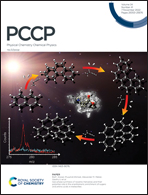Understanding the role of Cl doping in the oxygen evolution reaction on cuprous oxide by DFT†
Abstract
Designing highly active and earth-abundant oxygen evolution reaction (OER) electrocatalysts for electrochemical water splitting remains a challenge. Recently, Cl-doped Cu2O has emerged as a very promising non-noble-metal electrocatalyst candidate for the OER. However, the mechanism of the OER catalyzed by Cl-doped Cu2O has not been explored systematically. Herein, a comprehensive density functional theory (DFT) study is employed to study the role of Cl doping via comparing the OER on pure and Cl-doped Cu2O surfaces with/without Cu vacancies. Our results reveal that Cl doping increases the adsorption ability of Cu2O(111) by providing an excess electron, while a Cu vacancy decreases its adsorption ability by changing the geometric structure of the adsorption sites and the electronic structures. Cl–Cu2O(111) (η = 0.58 V) and VCu–Cl–Cu2O(111) (η = 0.46 V) have comparable or even better OER activity than those of widely used OER electrocatalysts such as the IrO2 catalyst (η = 0.56 V). It is facile to have a Cu vacancy when Cu2O(111) is doped with Cl because of a large strain introduced by Cl doping. Thus, VCu–Cl–Cu2O(111) should be the most feasible catalyst for the OER catalyzed by Cl-doped Cu2O material. The dual role of Cl doping is that it not only increases the OER activity but also helps to form a Cu vacancy. The results show that Cu2O(111) activity can be greatly enhanced via electronic and geometric structure modulation, which is helpful for the design of more efficient Cu2O-based catalysis.



 Please wait while we load your content...
Please wait while we load your content...